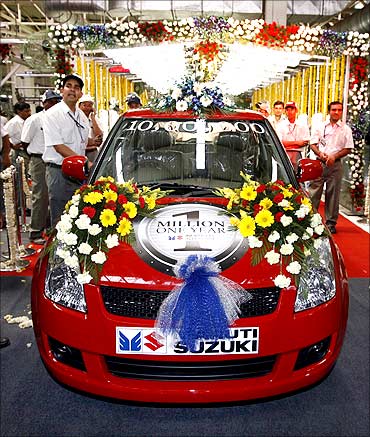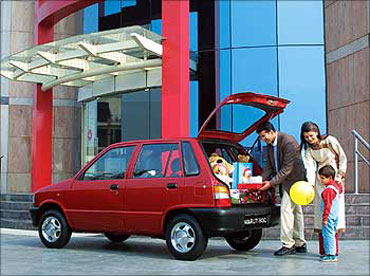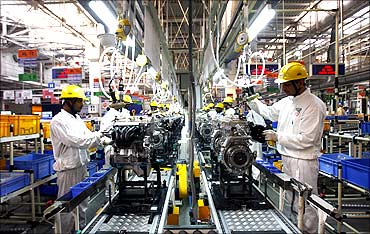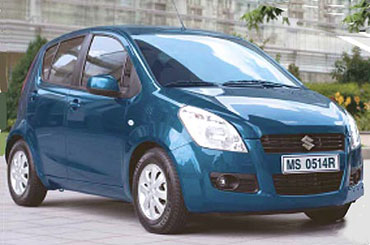
When the going is too good, a little bad news here and there is not entirely unexpected. Which is why the unexpected dent in Maruti Udyog's profits this past quarter, after successive quarters of superlative performance, should not have come as jolt to start with.
But it did because the cause of the nasty drop in profits was not something anyone could have expected -- a sudden hike in royalty served up to the parent on a well-greased platter. That made everybody sit up alright.
Maruti pays a portion of sales as royalty to its Japanese parent Suzuki for using technology provided by it. Its move to hike royalty not only hurts its profit margin for the current quarter but also impacts the value of future cash flows dramatically, especially in the face of declining margins.
Now, despite a sturdy 27 per cent growth in sales over the same quarter in the previous year and an expected increase in raw material costs, operating margins are down a substantial 280 basis points compared to the immediate previous quarter and 160 basis points from the year-ago period because the royalty payment to the parent went up from 3.5 per cent of sales to 5.1 per cent.
The hike in royalty may look like a small percentage but consider this for some perspective: Maruti's raw material costs as percentage of sales comprise nearly 80 per cent of total costs based on the past five-year average.
Which means there is only the remaining 20 per cent to accommodate other operating costs, including staff overheads, and then onwards to some profits.
Last fiscal, the operating margin for Maruti stood at 13 per cent and net margin at 8.7 per cent. Thanks to the increased royalty rate, operating margin for the past quarter fell to 8.86 per cent and net margin to 5.35 per cent.
In isolation, it's unimpressive enough but it pales even more if you compare it with the quantum of capital expenditure required for carmakers.
. . .
Powered by 

Free cash flows are the real proof of profitability -- it is the excess cash earned by a business after it has paid for all expenses, including the capital expenditure required to spur growth.
A business that does not earn free cash flows essentially would not earn anything for shareholders because all the money earned by it will be ploughed back to increase sales.
Imagine the thela-wala down the street selling chaat. What kind of profit will he make if all the money that he gets at the end of the day has to go back into the next day's sales? And then the next and then the one after it. Sure, he'll be doing business everyday but there aren't any real profits.
You could argue that the thela-wala can stop doing business one fine day and take the end of day proceeds as his profit. For a company it's simply impossible.
So for a company with no free cash flows, the value embedded in the company is the cash held in its bank account because its assets are useless as they can't make real profits.
Now see how Maruti fares on this count. Maruti spent about Rs 6,885 crore (Rs 68.85 billion) in capital expenditure largely to increase capacities between 2005 and 2010. This was against sales of Rs 108,032 crore (Rs 1,080.32 billion) and depreciation of Rs 3,191 crore (Rs 31.91 billion) through the period.
On average, capital expenditure as proportion of sales during this period amounted to 6.37 per cent.
Pitch it against the net margin of an average 6.39 per cent that the company would have earned over this period if the royalty was paid at the new rate of 5 per cent and it's not a pretty picture.
. . .
Powered by 

If you add back the depreciation -- the non-cash provision made every year for wear and tear of machinery -- the average margin over the period would have been 9.34 per cent.
That means, the company will be left with free cash flows of 2.97 per cent of sales. It is very likely that at least half of this margin could evaporate given the intensifying competition, making things even more unattractive. Sales realisations are already getting hit and are most likely to go down further.
Wrong side
The main grouse against the additional royalty charged by Suzuki is that it's not going to help the company come up with anything new or substantially better that will bring in additional sales.
The increase in royalty is in fact for the K Series petrol engine technology that the local company has already acquired from parent Suzuki.
Apparently, the upper limit set by the government on the royalty rate was removed in December 2009 and the parent is now charging a higher royalty for development costs that were not covered fully before.
It is not as though this is a one-time cost -- the increased royalty will have a bearing on the company's future cash flows. Maruti has said that royalty rates will not be increased further. But without a ceiling on royalty rates, it could be open season.
Assuming a sales growth of 12 per cent this fiscal, Maruti would end up paying about Rs 1,780 crore (Rs 17.80 billion).
According to Nomura Holdings, it takes about Rs 500-600 crore (Rs 5-6 billion) to develop a new car model in India. Tata Motors, India's largest auto company spends about Rs 1,500 crore (Rs 15 billion) on R&D. "We are therefore surprised by the extent of the royalty payment at MSIL [Maruti Suzuki India Ltd]," says Nomura analyst Kapil Singh is his report.
. . .
Powered by 

Then again, because company officials feel that the technology is coming at a competitive price, one could argue that if the technology is for the engine, then why not charge royalty only on the value of the engine.
Normally, the value of the engine is less than 20 per cent of total sales value of a car.
Moral questioning aside, more than royalty will be blocking Maruti on the road ahead.
Switching lanes
Unfortunately, the increase in royalty comes at a time when the company is up against very tough competition. Almost all big car-makers in the country are invading the small car market, which is Maruti's main forte.
On the one hand, GM is getting aggressive at the entry level, a threat to models like Alto and WagonR. On the other, you have competition steaming up from the likes of VW, Toyota and Honda, a threat to models like Swift and Ritz.
Not that Maruti does not have an attractive line-up. It plans to launch factory-fitted bi-fuel CNG variants across all product categories. This segment has little competition.
Besides, Maruti plans to launch a K10-engine variant of the new Alto in the coming month and, later this year, we can expect Kizashi, a higher-end car.
The pricing of new launches will be crucial. Take for example, the Alto K10 -- Maruti has decided to take a major leap by upgrading its largest selling entry level car from an 800cc engine to a fuel-efficient Kseries1000 cc engine.
. . .
Powered by 

"If MSIL raises the price of the new Alto, then it would closely compete with its Wagon R, its second largest selling model, priced in the next price point range. However, if it does raise the price for the Alto model upgrade, it will face margin pressure given the lower price point range and increasing costs associated with the upgrade," points out Binay Singh, auto analyst is his recent report.
All in all, in the coming two years, Maruti intends to spend about Rs 5,600 crore (Rs 56 billion) as capex. Of this, Rs 1,700 crore (Rs 17 billion) is likely to go towards adding capacity, another Rs 1,500 crore (Rs 15 billion) will go to research, and the remaining to ramp up distribution facilities.
Partly due to the expansion and mostly due to competitive pressure and raw material costs, analysts estimate the company will earn a return on equity of 14 per cent, substantially lower than the 20 per cent earned last fiscal.
Meanwhile, competition isn't cooling its heels and overall demand may well change over to the slow track because of the accelerated pace of sales in the past year and more.
So what does all this mean for the Maruti stock price? Maruti currently has cash balance of Rs 1,900 crore (Rs 19 billion) and marketable securities worth Rs 4,500 crore (Rs 45 billion) which translates into cash per share of Rs 220.
Assuming a sales growth of 15 per cent year-on-year for the next five years (this is probably the best case -- car sales growing at the nominal GDP growth rate or a clip higher), free cash flow margin of 3 per cent, a terminal growth rate of 8 per cent and a 15 per cent expected rate of return from equities, and considering the cash in the books, the equity value of the company is estimated at roughly 15,600 crore (Rs 156 billion).
The current market-cap of Maruti stands at -- ouch! -- Rs 34,900 crore (Rs 349 billion).
As a matter of fact, even the equity value assigned to the company is perhaps a bit liberal for two reasons: a) the free cash flow margin we have used is the margin earned by the company in the past five years after accounting for a five per cent royalty; this margin could come down further given competitive pressure; and b) the profit margins also have a hefty element of other income due to substantial cash in its books.
Almost all analysts have downgraded Maruti's stock post results at underperform/reduce/sell. But none has brought out the distressing situation Maruti seems to be in today.
More than the bad news on the royalty front, it is the sustainability of sales volumes and realisation that might end up killing Maruti right royally.
Powered by 